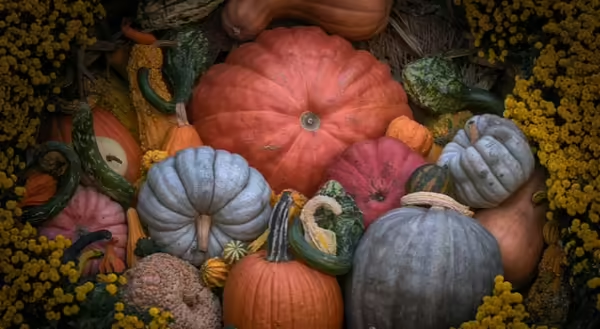
In falls fading light, toothy grins glow from neighborhood porches filled with pumpkins, squash, and gourds, festively displayed.
All members of one family (Cucurbitaceae), cucurbits (pumpkin, squash, and gourds) are very functional fruits. Not only are they flavorful; the source of food usually doubles as natural art and decor. Planted in spring, the small seedlings quickly grow large leaves and long sprawling vines — reaching lengths of 30 feet! Flowers, pollinated by various species of bees, mature from small green fruit into a unique and vibrant crop.
Pumpkin popularity The intricate carvings on large orange orbs seem timeless, but the tradition of carving food around All Hallow’s Eve began with turnips, beets, and potatoes — the first jack-o’-lanterns. While the trusty carving pumpkin proves a reliable canvas, these pumpkins are poor kitchen company. To bake a delicious pie, resource the sweet orange flesh commonly found in canned pumpkin — buckskin.
Pumpkins are thirsty.
Composed of 90% water, the typical pumpkin, containing hundreds of seeds, thrives in hot, dry weather. But in the heat of summer, when pumpkins are actively growing and setting fruit, they need one inch of water (or more) each week. Although the flesh of carving pumpkins is not delicious to eat, the seeds make a tasty treat.
Pumpkins set world records.
The largest pumpkin on record, the “Michael Jordan” pumpkin, weighs 2,749 pounds. It was proudly, and painstakingly, grown by a Minnesota horticulture teacher. If growing one of these massive fruits sits on your bucket list, beware the meticulous planning and care. Requiring at least 120 days to mature, these jumbo varieties must be started early indoors and require well-managed growing conditions.
Gourds, the inedible cucurbits.
With a hard-shell that dries well, these fruits were used as utensils, musical instruments, toys — even storage containers. Grown today less for necessity, more for attraction, gourds are common in crafting, birdhouse building, or natural fall displays. With environmentally friendly home and personal care products trending, consider going zero-waste by growing your own luffa gourd. The exfoliator is produced by drying the luffa fruit, then removing the outer shell to reveal the natural sponge.
Squash is versatile.
Categorized based on the season it is grown for, summer and winter squash crops can provide a source of vegetables nearly year-round. Summer squash, like zucchini, is harvested throughout the summer as young fruit. Winter squash is harvested mature, in the fall, and is typically grown for winter storage. Depending on the variety, winter squash can be stored in a cool, dry, and well-ventilated space for one to six months. Winter squash adds a rich flavor to hearty autumnal recipes including soups, baked casseroles, and baked goods.
Pumpkin pollination—A monster mash.
Crops in the Cucurbitaceae family can cross-pollinate, resulting in seeds that can produce unique harvests next year. Experimentation produces some ghoulish fruits (both unsightly and deformed) spooking some gardeners and thrilling others. Whether they cause a fright or reveal your Frankenstein core, the celebration of autumn is the perfect stage to display the monstrosities that could grow from cross-pollinated seeds.
If you are looking for a safe, normal pumpkin, squash, or gourd, buy new seeds every year. Garden centers and seed companies maintain high-quality seed for old and new varieties so there is certain to be a perfect pumpkin for you. Plan carefully though, cucurbits are notorious for taking over a garden… but their unique shapes and flavor make it worth every square inch of vine.
Photo credit: cucurbits_Photo by Robert Zunikoff on Unsplash
ABOUT THE AUTHOR: Brittnay Haag is a horticulture educator with University of Illinois Extension, serving Livingston, McLean, and Woodford Counties. Her work focuses on youth horticulture education, specifically through school gardens and Jr. Master Gardener programs. Brittnay provides leadership for three county Master Gardener programs and is responsible for developing community programs and providing expertise in horticulture and environmental sciences.
ABOUT THE EDITOR: Liz Repplinger is an agriculture and natural resources program coordinator serving Livingston, McLean, and Woodford Counties. A Bloomington-Normal native, Liz earned a B. A. and M.S. in Animal Science from Illinois State University. She has enjoyed contributing to the multiple facets of Extension including previous support of the 4-H Youth Development Program as a program coordinator and current support of Unit and Statewide Diversity, Equity and Inclusion Initiatives.